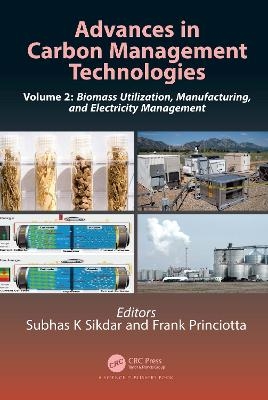
Advances in Carbon Management Technologies
CRC Press (Verlag)
978-0-367-52049-6 (ISBN)
- Titel z.Zt. nicht lieferbar
- Versandkostenfrei
- Auch auf Rechnung
- Artikel merken
Volume 2 of Advances in Carbon Management Technologies has 21 chapters. It presents the introductory chapter again, for framing the challenges that confront the proposed solutions discussed in this volume. Section 4 presents various ways biomass and biomass wastes can be manipulated to provide a low-carbon footprint of the generation of power, heat and co-products, and of recovery and reuse of biomass wastes for beneficial purposes. Section 5 provides potential carbon management solutions in urban and manufacturing environments. This section also provides state-of the-art of battery technologies for the transportation sector. The chapters in section 6 deals with electricity and the grid, and how decarbonization can be practiced in the electricity sector.
The overall topic of advances in carbon management is too broad to be covered in a book of this size. It was not intended to cover every possible aspect that is relevant to the topic. Attempts were made, however, to highlight the most important issues of decarbonization from technological viewpoints. Over the years carbon intensity of products and processes has decreased, but the proportion of energy derived from fossil fuels has been stubornly stuck at about 80%. This has occurred despite very rapid development of renewable fuels, because at the same time the use of fossil fuels has also increased. Thus, the challenges are truly daunting. It is hoped that the technology choices provided here will show the myriad ways that solutions will evolve. While policy decisions are the driving forces for technology development, the book was not designed to cover policy solutions.
Subhas K Sikdar retired as Associate Director for Science, National Risk Management Research Laboratory of USEPA. Earlier he held technical and managerial positions at Occidental Research Corp, National Institute of Standards and Technology, and General Electric Corporate Research & Development Center. Dr. Sikdar is an elected Fellow of AAAS, ACS, AIChE, IIChE, and winner of EPA bronze medals, R&D 100 awards, several national awards from AIChE, and distinguished achievement awards from EPA, University of Arizona, and University of Calcutta. He is Editor-in-Chief of Clean Technologies and Environmental Policy (Springer), and serves as a member of the conference committee of Engineering Conferences International. He has edited 16 books. Frank Princiotta recently retired as Director of the Air Pollution Prevention and Control Division of the Office of Research & Development, Environmental Protection Agency. He has a degree in Chemical Engineering from City University of NY (Tau Beta Pi, Omega Chi Epsilon) and a Nuclear Engineering Certificate from the Oak Ridge School of Reactor Technology. His division is responsible for RD & D on technologies for controlling and characterizing air pollution from major sources. He has been a key agency expert in air pollution control for over 40 years. He has been the recipient of an EPA gold medal, and three bronze medals for his accomplishments in the air pollution control field. He has also received the President's Meritorious Executive Award on two separate occasions (Presidents Carter and H.W. Bush). He played the leadership role in the development and demonstration of sulfur dioxide pollution control technology for coal-fired boilers, which has been the mainstay of SO2 control worldwide. An author of many scientific papers on air pollution control, he has been a frequent speaker before technical societies and conferences and has testified before Congressional Committees. In recent years he has focused on mitigating global climate change. He has analyzed the role that technology and cultural changes will need to play, if we are to avoid the potentially catastrophic impacts associated with unconstrained use of energy.
Introductory Chapter. What key low-carbon technologies are needed to meet serious climate mitigation targets and what is their status. SECTION 1. BIOMASS SECTOR. Biomass as a source for heat, power, and coproducts. The Brazilian experience on the use of bioethanol. Biomass in regional and local context. Prioritizing uses for woody biowaste: a case study from British Columbia. Industrial oleochemicals from used cooking oils (UCOs)- sustainability benefits and challenges. Advances in carbon capture through thermochemical conversion of biomass waste. Phytowaste processing. Anaerobic digestion for energy recovery and carbon management. Critical aspects in developing sustainable biorefinery systems based on bioelectrochemical technology with carbon dioxide capture. Synthesis of regional bioproducts supply networks. Supply chain analysis for advancing carbon and nutrient recovery from organic waste. Efficient and low-carbon energy solution through polygeneration with biomass. SECTION II. MANUFACTURING AND CONSTRUCTION (BATTERIES, BUILT ENVIRONMENT, AUTOMOTIVE, AND OTHER INDUSTRIES). Urban carbon management strategies. Lean and green (L&G) manufacturing. Advances, challenges and opportunities of Li-ion batteries for electric vehicles. Charging strategies for electrified transport. SECTION III. ELECTRICITY AND THE GRID. Microgrids’ role in grid decarbonization. Storage of fluctuating energy. Lithium ion batteries – future technology development driven by environmental impact. Carbon constrained electricity sector planning with multiple objectives.
| Erscheinungsdatum | 02.02.2021 |
|---|---|
| Zusatzinfo | 58 Tables, black and white; 25 Line drawings, color; 123 Line drawings, black and white; 3 Halftones, color; 23 Halftones, black and white; 28 Illustrations, color; 146 Illustrations, black and white |
| Verlagsort | London |
| Sprache | englisch |
| Maße | 178 x 254 mm |
| Gewicht | 880 g |
| Themenwelt | Technik ► Elektrotechnik / Energietechnik |
| Technik ► Umwelttechnik / Biotechnologie | |
| ISBN-10 | 0-367-52049-4 / 0367520494 |
| ISBN-13 | 978-0-367-52049-6 / 9780367520496 |
| Zustand | Neuware |
| Haben Sie eine Frage zum Produkt? |
aus dem Bereich


